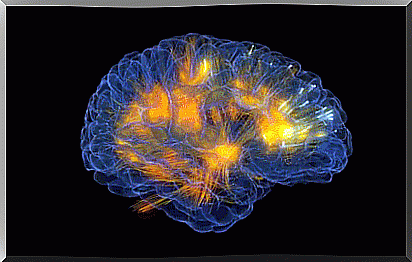10 Facts About Our Dreams That Will Amaze You

Dreams have been a source of mystery to man since time immemorial. We have always been curious about our dreams. For many years, mankind was unsure whether the scenes that paraded through their minds at night were real or not. Over the centuries they were given a magical or mystical explanation, always being associated with a reality that was beyond comprehension.
Greek mythology is very eloquent when it comes to this subject. To the ancient Greeks, the god Chaos, the twin brother of Thanatos, or Death, had two sons. One was Nicte, or the night, and the other was Erebus, or the darkness of hell. These two brothers had a son: Hypnos, god of sleep. Chaos and Death gave rise to night and darkness. From that unique combination, dreams were born.
In turn, Hypnos had three children: Morpheus, Phobetor, and Phantasos. Morpheus is the one who appears in people’s dreams. He takes the form of anyone he wants. Therefore, each human figure that appeared was no more than another personification of Morpheus. Phobetor did the same with animals and Phantasos with inanimate objects. To the Greeks, human dreams were nothing more than a list of the gods.
These aren’t the only quirks out there. First it was mythology and then science that found or revealed fascinating data. The following 10 tidbits are some of the most interesting.

1. The unusual increase in brain activity
The only thing we let rest when we sleep is consciousness. Far from resting, our brains work intensely during dreams. Even in the deepest stages of sleep, when there are slow waves, the activity doesn’t stop for a second.
What does happen is that in some phases there are certain areas of the brain that work more slowly and in a more coordinated way. However, during the so-called REM phase, there is a real burst of activity. If we make an encephalogram at this stage, we see that it shows a pattern very similar to that of an awake person.
2. We spend about 6 years of our lives dreaming
When we sleep, we dream. There is no other alternative. Those who say they don’t dream simply don’t remember their dreams. Once we sleep, there is no way to stop dreaming. Finally, we’ve answered one of the most frequently asked questions about dreams.
Research indicates that the actual stages of sleep occur in periods of 5 to 20 minutes. If you take all those fractions and add them up, you need about 6 years of your life to dream. For this statistic, the general life expectancy at that time was taken as the reference.

3. The dreams of men and women are different
Some studies have found subtle differences between men’s and women’s dreams. The contrast between the one and the other mainly occurs in terms of the content of dreams. The scenes and characters vary from one gender to another.
According to some studies, men dream more about scenarios and situations where there is aggression. On the other hand, women have slightly longer dreams. In it, the details are more numerous and the situations more complex.
4. Not all dreams are in color
Another frequently asked question about dreams is whether they are all in color or can they be black and white. Information gathered by dreamers suggests that eight out of ten dreams are in color. Everyone has black and white dreams. However, a small percentage never manage to dream in color, or they never seem to remember the color.
In an experiment, a group was asked to select a group of colors that they associate with sleep. This request is made to them immediately after they have worked. Almost all respondents indicated pastel shades. So it can be concluded that we tend to dream in pastel colors.
5. Negative emotions are more common
During our dreams we not only visualize scenes and characters, we also experience many emotions. This is fully demonstrated in Calvin Hall’s extensive research on dreamers. This researcher managed to collect 50,000 stories related to dreams.
As expected, he confirmed that we experience all kinds of emotions while sleeping. Surprisingly, however, the most commonly mentioned condition was anxiety. There was also a clear predominance of other negative emotions, such as fear and anger, during the dream.

6. There are universal dreams
Scholars of the subject have revealed that there are some recurring dreams. The most remarkable thing is that they also occur in very different cultures. That’s why we speak of them as “universal dreams” or of content that we all dream of at some point.
One of the universal dreams is that of persecution. Also , almost everyone has dreamed that they were attacked by someone or that they ended up in a void. Dreams about being bullied at school or about being naked in front of a large number of onlookers are also very universal.
7. Former smokers dream more vividly
According to a report published in the journal Abnormal Psychology , people who have smoked for a long time and then quit smoking have dreams that are more vivid than normal. In other words, dreams that are more realistic and vivid.
In a study of 243 people who had quit smoking, 33% reported having dreams related to smoking. This happened between one and four weeks after they stopped. 97% stated that they never dreamed about smoking before quitting.

8. Only famous people and things appear in our dreams
One fact that has been established is that we never dream about people we don’t know. The brain doesn’t invent new faces. Those who parade through our dreams are people we’ve ever seen, even if only in passing.
However absurd the characters are in our dreams, they are never unknown persons. The same goes for objects. Sometimes objects appear that seem completely new to us. However, they are a composition or deconstruction of known objects.
9. External Stimuli Occur in Our Dreams
After conducting some studies, the phenomenon known as ‘incorporation of the dream’ was verified. This is one of the most interesting curiosities about our dreams. It refers to the fact that the content of the environment sometimes integrates with that of the dream. They merge in a way that can be called ‘coherent’.
This happens when, for example, the person dreams of being at school, in a class. Suddenly their alarm clock rings in real life and becomes the school bell in the dream.

10. Paralysis While Sleeping
In this case, we are not talking about the well-known and dreaded sleep paralysis. What we are referring to is the physiological fact that occurs when we sleep. Some glands secrete a hormone that causes sleep. Then the neurons send signals to the spinal cord to relax. As the dream progresses, there is no longer just relaxation, but paralysis.
This brain mechanism has a purpose. Imagine that a person could act at any time during their sleep. This would pose some risks, especially in certain environments. That is why the paralysis caused by this process guarantees that the body remains at rest until it awakens.
Science has not yet unraveled all the riddles and curiosities about this subject. Moreover, it has not even been able to elucidate the exact reasons why we sleep and dream. It is already known that in any case we do not rest. Therefore, the world of dreams remains an unknown kingdom, which we enter daily and from which we daily leave, without realizing the miracle.








